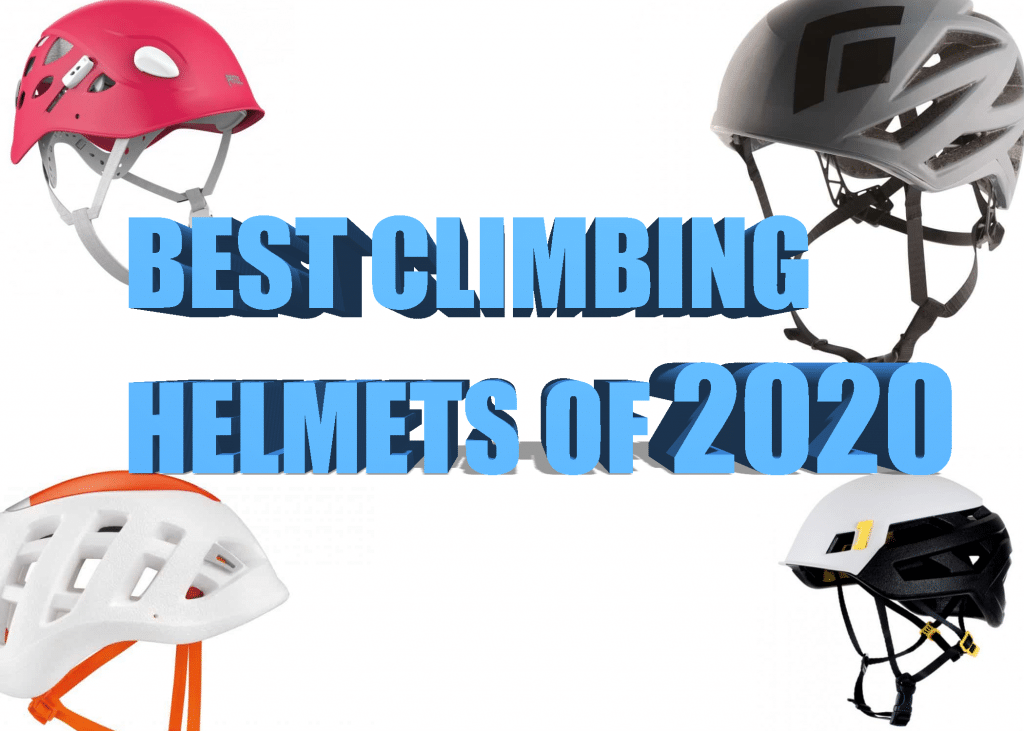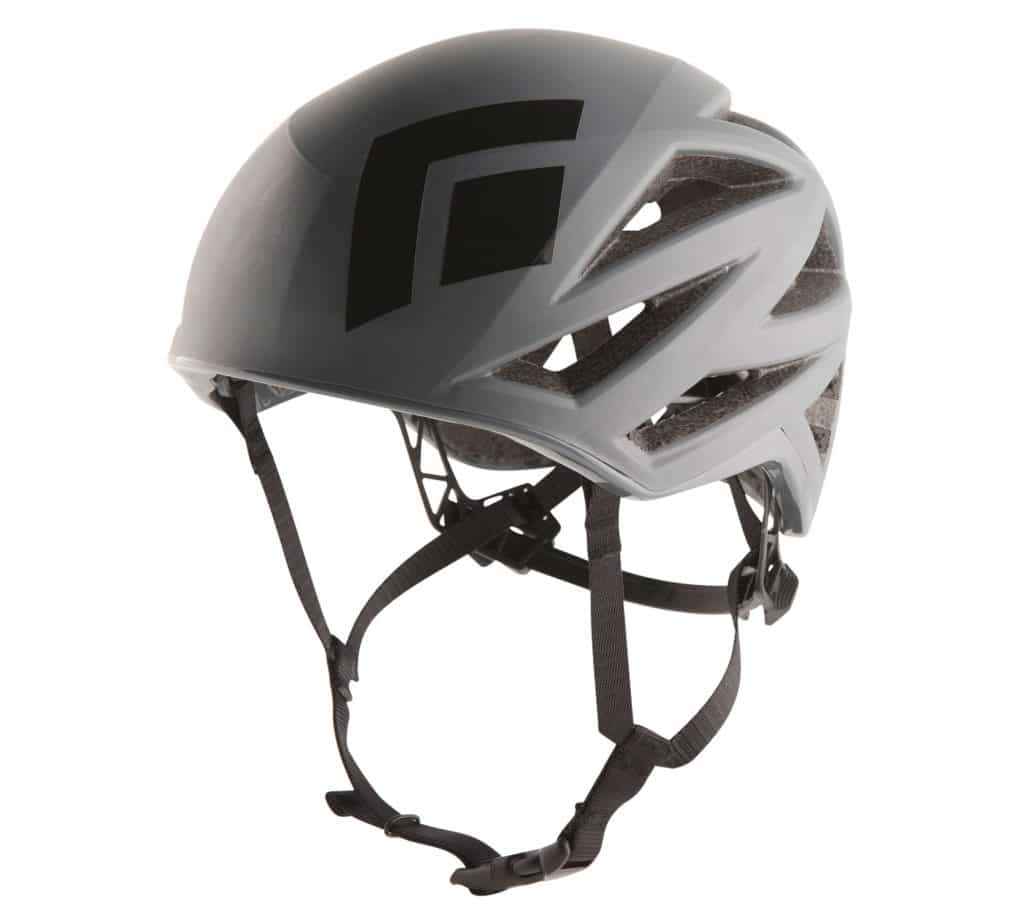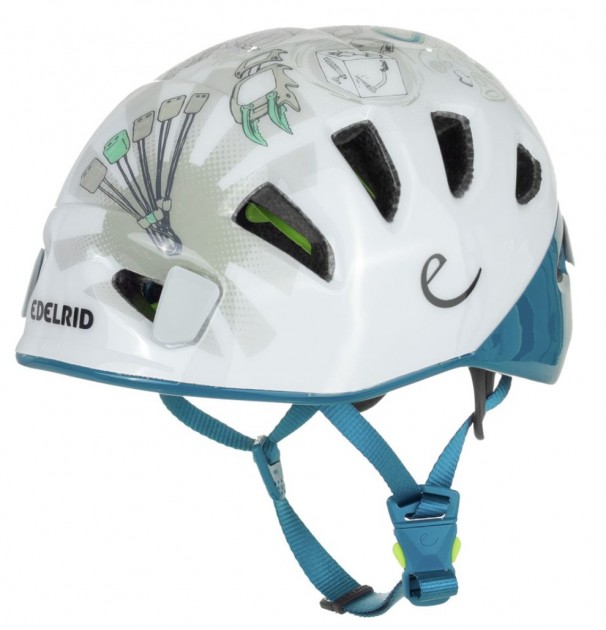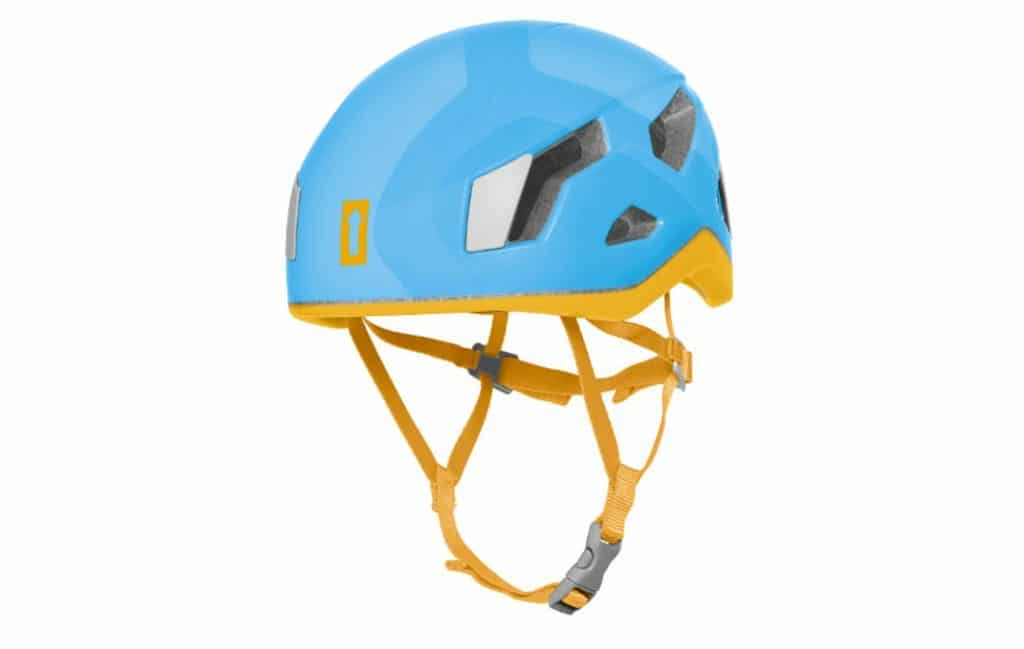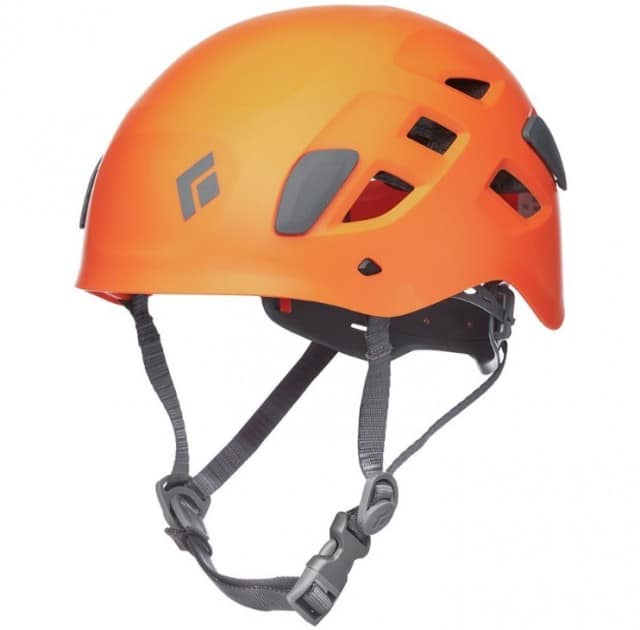Table of Contents
The fact that all or most professional climbers nowadays wear helmets to protect them from rocks and banging their head speaks for itself. One accident can be enough to leave you severely injured, and your head is especially sensitive to injuries. If you’re still not convinced, read more here. But which climbing helmet to pick in 2022? There are so many models – well, we tested 14 of the most promising models!
The best climbing helmets of 2022? Our winner for overall best value and performance climbing helmet of 2022 is Petzl Meteor, but if you look for the best helmet money can buy the Mammut Wall Rider MIPS. The cheapest helmet is the Mammut Skywalker 2, but you will need to live with disadvantages that it is poorly fitting, heavy, and not very well ventilated.
By the way, all our reviewed helmets are safe and protect well, this is actually tested with independent standards like the UIAA, read more here.
In a perfect world, you wouldn’t need a helmet: If there is a chance of falling rocks, you shouldn’t climb, and you can be extra careful to avoid it too. But that’s not the reality, and you will fall and bang your head. Finding a very comfortable helmet is super important because a heavy and clunky helmet will be left at home.
No matter what kind of helmet you look for, the list and review of these top climbing helmets for 2022 will suit you. If you’re just looking for a certain design, need as much protection as possible, or just want a good helmet for cold weather, there is one to suit your needs!
For this review, we collected the 13 most promising helmets for 2022 that are available both in the US and Europe. Some of these are updated for 2022, and some are the same as the 2019 models. We tested many different helmets from a variety of known brands like Petzl, Salewa, and Black Diamond. But we also included low-price options to have something in our test for every budget.
A climbing helmet needs to have some unique features; you won’t find in cycling helmets, for example. Climbing helmets need to be able to resist multiple impacts without cracking, and there are some more differences. I actually wrote an article about there differences between bike and climbing helmets here.
REVIEW AT A GLANCE- TABLE – BEST CLIMBING HELMET OF 2022
| Score | Product | Price | Our Verdict |
|---|---|---|---|
|
4.8/5
|
Petzl Sirocco
|
$140 | An ultra-comfortable helmet that makes you forget you wear one at all. |
|
4.7/5
|
Black Diamond Vapor
|
$140 | This helmet is super lightweight but easy to dent. Even a slight touch to the rock will dent it. |
|
4.7/5
|
Petzl Meteor
|
$100 | Made from EPS foam, highly adjustable, can be used for ski and climbing. |
|
4.6/5
|
Mammut Wall Rider MIPS
|
$180 | MIPS provides extra security against brain injuries. |
|
4.5/5
|
CAMP USA Storm
|
$100 | Great to adjust, but it’s a heavy helmet. |
|
4.5/5
|
Black Diamond Vector
|
$100 | Good price doesn’t weigh a lot, pretty adjustable. |
|
4.2/5
|
Mammut Wall Rider
|
$120 | Not light like the Sirocco, but cheaper and very adjustable. |
|
4.1/5
|
Edelrid Shield II
|
$100 | Heavy EPS helmet that is very durable. |
|
4/5
|
Petzl Elia – Women’s
|
$65 | A women’s helmet – it will fit a ponytail! Otherwise durable and adjustable. |
|
3.7/5
|
Black Diamond Half Dome
|
$60 | Inexpensive all-round helmet, but it is heavy. |
|
3.6/5
|
Petzl Boreo
|
$70 | Good if you don’t want to spend a lot of money |
|
3.6/5
|
Singing Rock Penta
|
$60 | Good if you don’t want to spend a lot of money |
|
3.5/5
|
Mammut Skywalker 2
|
$40 | Heavy, not too good to adjust. Inner foam easily damaged. |
Our 2022 Review of The Best Climbing Helmets
For our 2022 review of the best climbing helmets, there are several contenders. Many of these models are known from 2019 and 2018, but some models had updates in 2021 or for 2022.
That said, all of the tested helmets will protect you well are certified with US and European safety standards. If you pick just any from the helmets on our list, you will always be safe and well protected. They just come in different forms and colors, and of course, the comfort level and weight differ.
The Helmets – Best Climbing Helmets of 2022

Petzl Sirocco – Rating: 4.8/5 Price: $140
Short Facts
- MATERIAL: EPP Foam inside, top piece EPP foam, one-piece crown no ABS or plastic top
- WEIGHT: 5.9 oz
- Price: $140
Our Verdict
Petzl’s Sirocco helmet is our overall winner. For the money, this is the best helmet you can buy. It’s lightweight and comfortable, and the inside is shaped like a head. The head plate is made from EPS, and the inside is resilient EPP foam. Thanks to the head plate, this helmet can resist falling rocks and ice. Overall this helmet combines comfort and protection with very lightweight.
Activity that it’s best at
Petzl’s Sirocco is great at any type of climbing: Sport, traditional and alpine multi-pitches, it gets the job done.
Pros
- Super lightweight
- Sits and feels ultra-comfortable
- Great air ventilation
- Can be used for skiing and mountaineering
- Supreme protection for all sides of the head
Cons
- ABS helmets are more durable
- Very expensive
- Not so good to adjust
- Magnetic buckle can feel weird
Black Diamond Vapor – Rating: 4.7/5 Price: 140$
Short Facts
- MATERIAL: EPS Foam and a Polycarbonate Shell
- WEIGHT: 7 oz
- Price: $140
Our Verdict
We think the Black Diamond Vapor is a good helmet. It is very lightweight, and we think it’s almost a bit too light. Here is the thing: It almost feels as if Black Diamond was giving up on robustness and durability and even adjustability because they wanted to save weight. It’s also expensive and doesn’t really offer any benefit over some cheaper helmets. That said, it’s still a great ventilated helmet that will serve you well.
Activity that it’s best at
Black Diamonds Vaper is really good for hot weather climbing as it’s light and comfortable. Other than that, any type of climbing where there is not a lot of rocks and small debris raining from the top.
Pros
- Super ventilation
- Very light-weight
- Almost feels like not wearing a helmet, i.e., is perfect for hot weather
Cons
- Top feels almost fragile
- Can’t adjust chin strap forwards
- Headlamp clips are removable and easy to lose
- Not very abrasion resistant
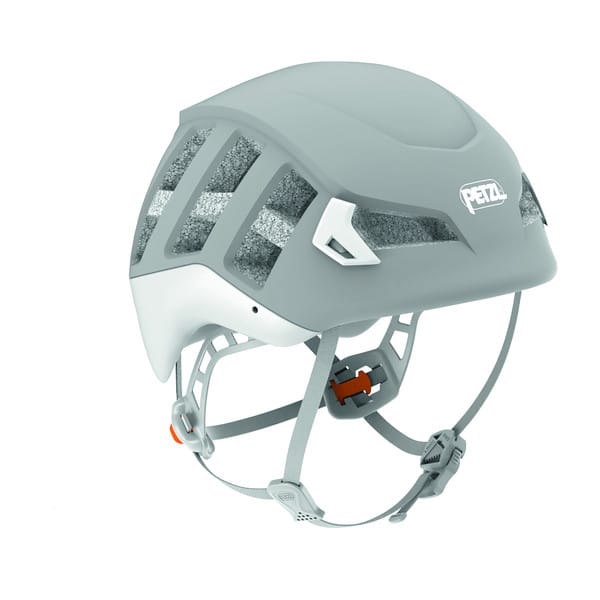
Petzl Meteor – Rating: 4.7/5 Price: $100
Short Facts
- MATERIAL: molded EPS Foam and a Polycarbonate Shell
- WEIGHT: 8.5 oz
- Price: $100
Our Verdict
The Meteor was redesigned for 2019, and if you need a lightweight helmet, this helmet delivers a lot of bang for the money. It’s not as cheap as the Black Diamond Half Dome, which only costs $60, but the Meteor is a lot lighter and more comfortable. If you compare it to the overall winner the Sirocco, this helmet is a little heavier and overall scores lower, but also costs less. It’s like the middle ground between entry-level cheaper helmets and really expensive helmets: A good choice if you need a light new helmet that is good for any type of climbing.
Activity that it’s best at
You can use the Meteor for any type of rock climbing, ice climbing, mountaineering, or ski mountaineering.
Pros
- Super ventilation
- Very light-weight
- Magnetic buckle collects dirt too
Cons
- Heavier than top models
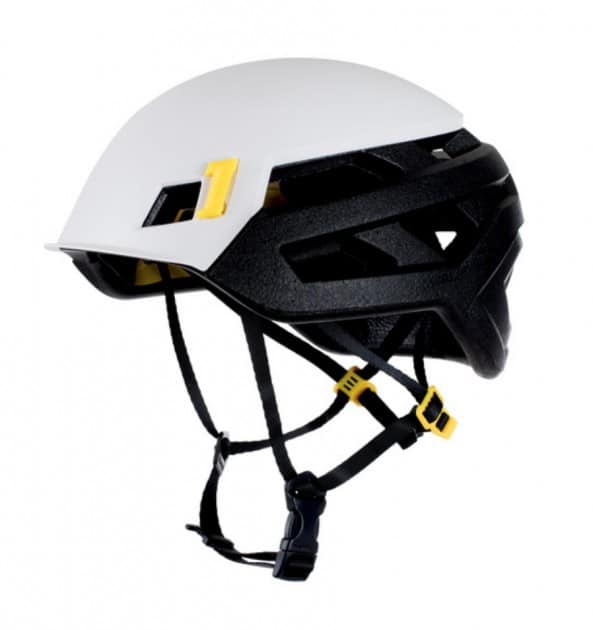
Mammut Wall Rider MIPS – Rating: 4.6/5 Price: $180
Short Facts
- MATERIAL: molded EPP Foam and hard plastic top
- WEIGHT: 9.5 oz
- Price: $180
Our Verdict
The Wall Rider is the first climbing helmet we know of that has MIPS. MIPS is a technology that basically acts as a thin free-floating plastic piece that allows the helmet to move a tiny little bit when you take a blow, which helps to deflect impact forces on your brain. MIPS is very common among bike helmets today, but it’s new for climbing helmets. If you need the helmet with possibly the best protection, there is no way around the Wall Rider with MIPS technology. There will probably be more companies to develop helmets with MIPS in the next years. And this technology, which costs a little bit more, has the potential to avoid life-changing injuries, so it’s worth the money!
Activity that it’s best at
You can use the Wall Rider for any type of rock climbing, ice climbing, mountaineering, or ski mountaineering.
Pros
- MIPS technology to protect your brain
- lightweight
- good ventilation
- feels nice and comfortable
- technology, lightweight, well-ventilated, comfortable
Cons
- Very expensive
- Not great to adjust
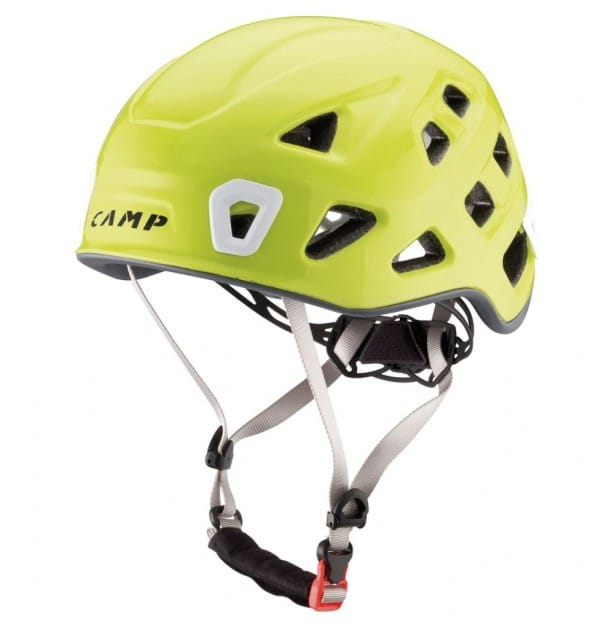
CAMP USA Storm – Rating: 4.5/5 Price: $100
Short Facts
- MATERIAL: EPS Foam and polycarbonate top
- WEIGHT: 8.7 oz
- Price: $100
Our Verdict
The Storm helmet combines some of the aspects of other CAMP USA helmets like the Speed 2.0, which is a climbing and ski mountaineering helmet and puts them into a helmet for climbing. It can be used for any type of climbing and is a good all-round helmet. It’s similar in construction to the Petzl Meteor, but with a different shape, and besides for the chin buckle tendency to overtighten, this helmet is a very good choice!
Activity that it’s best at
You can use the CAMPUS USA Storm for any type of rock climbing, ice climbing, mountaineering, or ski mountaineering.
Pros
- Easy to adjust
- good headlamp clips that can be used easily
- holes for ventilation work super well
Cons
- Chinstrap buckle can be annoying as it buckles under the chin
- Easily over tightened
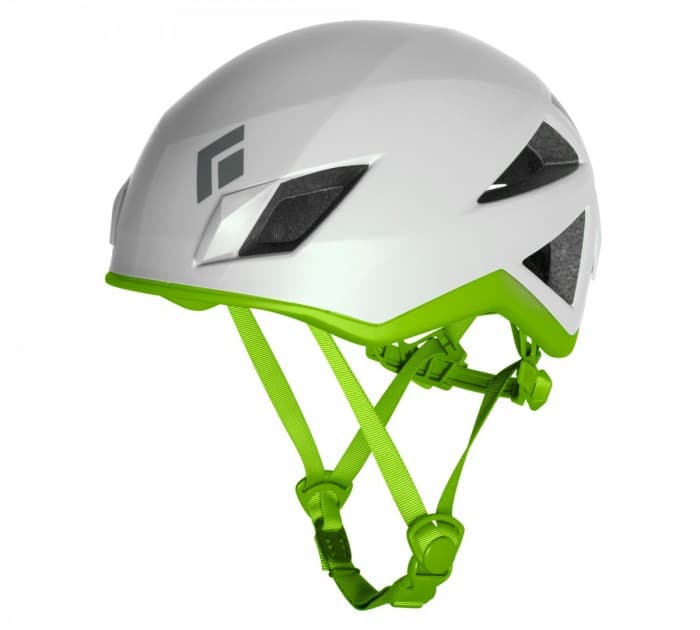
Black Diamond Vector – Rating: 4.5/5 Price: $100
Short Facts
- MATERIAL: EPS Foam and thin polycarbonate top
- WEIGHT: 8.6 oz
- Price: $100
Our Verdict
The Black Diamond Vector helmet is a pretty good package. It is lightweight and has a very adjustable inner harness. The headlamp clips work well, and the helmet is durable. Compared to the Vapor, it’s not as well ventilated but also feels a lot less fragile. If you’re not only climbing in very hot temperatures, this helmet is probably a cheaper and better fit than the Vapor, just because of the subjective feel.
Activity that it’s best at
You can use the Vector for any type of climbing, but long climbs in searing hot sun could be less comfortable than with some of the better ventilated other helmets
Pros
- Adjustable harness can be adjusted fully
- Rear adjustment made from rigid, robust plastic
- Lightweight
- Excellent working headlamp clips.
Cons
- For a lightweight helmet, the ventilation is only so-so
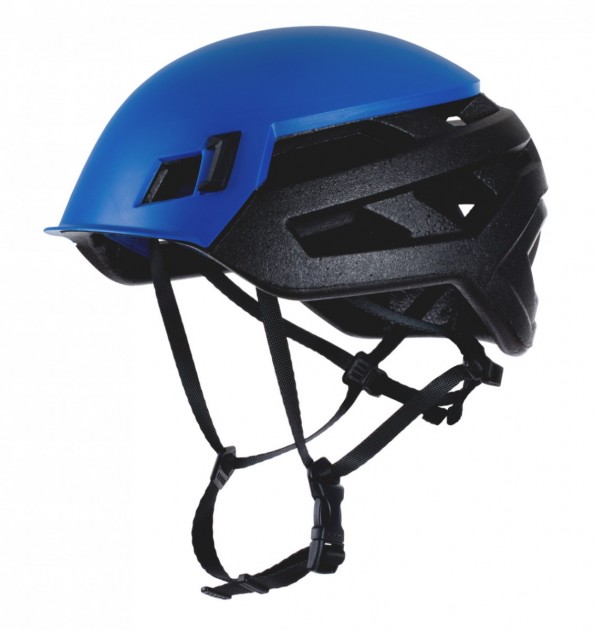
Mammut Wall Rider without MIPS – Rating: 4.2/5 Price: $120
Short Facts
- MATERIAL: EPP Foam and a plastic top
- WEIGHT: 9 oz
- Price: $120
Our Verdict
This is the same helmet like the one with MIPS only that it comes without MIPS. Other than that, they are pretty much the same: A comfortable, lightweight helmet with good ventilation. If you don’t like the Petzl fit, this helmet is a great alternative. It is only 0.5 oz lighter than the MIPS variant, making it one of the heavier helmets in the price range of over $100. If you don’t mind the $60 raise, get the version with MIPS! The headlamp clips are not so great to handle, but they’re ok once you get used to them.
Activity that it’s best at
The Wall Rider can be used in any type of climbing, ski mountaineering, or mountaineering!
Pros
- Adjustable
- Light
- Comfortable
- Plastic top very robust
Cons
- Not as light as some other helmets in this price range
- Expensive
- Headlamp clips are difficult to use
Edelrid Shield 2 – Rating: 4.1/5 Price: $120
Short Facts
- MATERIAL: EPS Foam and a polycarbonate top
- WEIGHT: 9.7 oz
- Price: $100
Our Verdict
The Edelrid Shield 2 is a fairly light helmet, given that it’s so robust. The shell feels solid, and the helmet is well ventilated. The design looks pretty cool if you like the graphical look, and the helmet is comfortable, although the adjustment knob on the back is quite large. It’s not a heavy helmet, but if you compare it to the Sirocco, you will feel a difference! The adjustments of the helmet are a little time-consuming.
Activity that it’s best at
The Shield 2 will fit any style of climbing just well.
Pros
- Large adjustment range possible
- Graphics look nice and well done
Cons
- Adjustment is time-consuming
- Headlamp clips are poor quality and pop out easily
Singing Rock Penta – Rating: 4/5 Price: $70
Short Facts
- MATERIAL: EPS foam with hard plastic cover
- WEIGHT: 7.2 oz
- Price: $70
Our Verdict
The Singing Rock Penta looks good and is light and cheap. The fit is a little bit questionable, so make sure to try it on if you have a large head. Although the strapping and webbing have no hard plastic pieces, it still sits well on the head but might feel weird to some people. It comes only in one size, but if it fits you, this helmet is a great cheap option for people who want a lightweight helmet, ventilation is good too. If you don’t know the brand: It’s from the Czech Republic, and they even have an official distributor in the US now, Liberty Mountain.
Activity that it’s best at
The Penta can be used for any type of climbing.
Pros
- Lightweight
- Low profile
- Comfortable and good ventilation
- Cheap
Cons
- All web harness, not super user-friendly
- Only one size: Hit or miss if you have a too large or small head
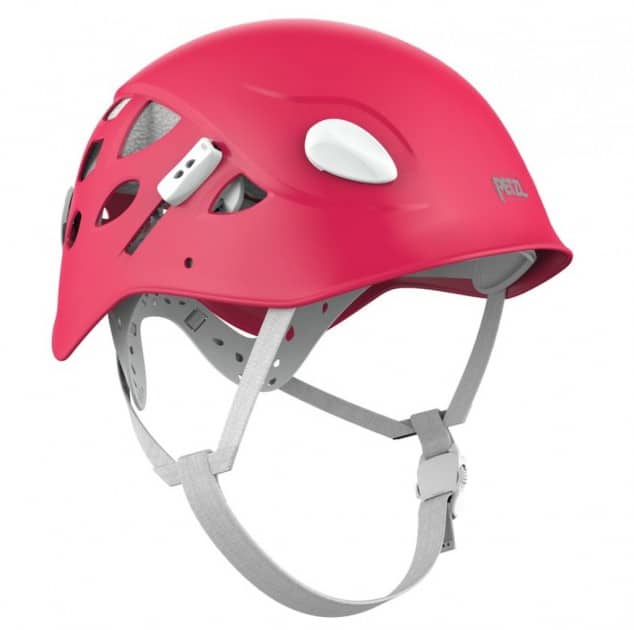
Petzl Elia Women – Rating: 4/5 Price: $100
Short Facts
- MATERIAL: EPS liner and ABS shell
- WEIGHT: 10.1 oz
- Price: $65
Our Verdict
Petzl’s Elia is one of the few women helmets, with a design to accommodate for long hair. The only other helmet we have in this test that has a women’s version to our knowledge is the Black Diamond Half Dome. This helmet here is actually a revamp of the discontinued Elios model that got redesigned to fit a ponytail. As it’s an ABS style helmet, it’s a bit heavier and not as well ventilated as the newer EPS or EPP foam helmets. Especially in summer, this can be uncomfortable. But it comes at a great price and fits long hair, which makes it unique in that regard!
Activity that it’s best at
The Elia will suit any climbing or mountaineering style.
Pros
- Good for ponytails
- Chinstrap easily adjustable
- Removable foam padding
- Durable
Cons
- Adjustment needs to be done every time you wear it
- Only one size
- Heavy
Black Diamond Half Dome – Rating: 3.7/5 Price: $100
Short Facts
- MATERIAL: EPS foam and polycarbonate shell
- WEIGHT: 12.7 oz
- Price: $65
Our Verdict
This helmet was updated in 2019 with a minor update, giving it a lower profile. The main problem, the weight, remained the same, though. That being said, there is a women’s version now of this helmet, which fits ponytails too! The update also gave this helmet a much-needed increase in ventilation. It’s not super comfortable nor lightweight, but for $65, you cannot complain about this. It’s probably among the most widespread helmets, as it looks good, is cheap to afford for beginners, does a good job, and is durable.
Activity that it’s best at
The Half Dome is perfect for sport climbing and traditional climbing and all sorts of mountaineering if you’re a beginner building a rack.
Pros
- Affordable price
- Hard plastic shell is pretty durable
- Can be adjusted in a wide range
- Easy to adjust too
Cons
- Heavy helmet
- Could be more comfortable,
- Ventilation not on par with more expensive helmets
- V-yoke not easily adjusted around the ear area
Petzl Boreo – Rating: 3.6/5 Price: $70
Short Facts
- MATERIAL: ABS shell, EPS foam on top, sides are EPP foam
- WEIGHT: 11 oz
- Price: $70
Our Verdict
This helmet was released in 2018 and is replacing the Petzl Elios. Thanks to the heavy-duty range of materials, these helmets offer really good protection but also are not light. The ABS shell is durable but also heavy. Adjustability is not very good, and ventilation is OKAYi, but not great. In our review, this helmet is probably the most rugged helmet. If you just want good protection and don’t mind the weight, this helmet is perfect!
Activity that it’s best at
The Boreo can be used in any type of mountain or climbing activity
Pros
- Durable and robust
- Very protective with good side protection
- Versatile for many different types of climbing
- Pretty affordable
Cons
- Heavy helmet
- Not too adjustable
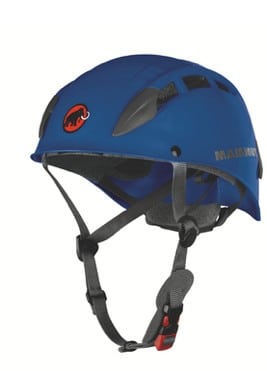
Mammut Skywalker 2 – Rating: 3/5 Price: $60
Short Facts
- MATERIAL: Hardshell polycarbonate outside, EPS foam inside
- WEIGHT: 13.7 oz
- Price: $60
Our Verdict
The Mammut Skywalker 2 is a clunky, heavy helmet that is fairly cheap. It was the heaviest and poorest fitting helmet we tested. As it sits very high in your head and is top-heavy, it often shifts to the side. This can be very irritating, and it gives you the “I’m a beginner and have rented ill-fitting gear” look we all love :D. Seriously, this helmet does not fit very well, and even though this is the heaviest helmet, the inside foam is not super durable. In our eyes, this helmet is the weakest option of the test!
Activity that it’s best at
The Skywalker 2 can be used for any type of climbing
Pros
- Inexpensive
- Outer shell durable
- The adjustable knob is strong
Cons
- Heavy
- Flanges on foam easy to break
- Sits very high on the head
- Shifts to the side a lot
- Bad ventilation
This Article is Updated and New for 2022
This article is kept updated and will expand over time. This is because the manufacturers are still releasing new models. By updating this list and review, we will always make sure that you have a good and current list of reviewed climbing helmets for 2022.
Choosing the right climbing helmet for your needs also comes down to your personal preference and what style of climbing you like best. Depending on the climate and if you are climbing multi-pitch routes in exposed alpine conditions in the Rockies, your choice can be very different from someone who loves sport climbing in Greece.
That’s why we included a little guide to find the right climbing helmet. Read more for details!
There Are Two Kinds of Climbing Helmets: Foam Cap and Rigid Cap
Most climbing helmets today come with a rigid shell and foam inside to keep the helmet in place. But there are some models where the outer shell is made from foam as well. Both are safe and can resist debris and rocks, but the helmets with a rigid outer shell tend to be more durable in terms of scratches and nicks.
In-mold helmets
These helmets come with an outer shell made from polycarbonate, but it is welded to the inner shell using EPS. Outer and inner shell are actually one piece. This technique is good to keep the outer shell thin and lightweight. Generous ventilation openings help to keep the head cool when outside in hot temperatures. In-mold helmets are very common for bike, ski, and mountaineering helmets as well as climbing helmets.
Hardshell helmets
The outer shell is made from hard plastic or even carbon fiber that is attached to the inner shell of the helmet. The inner shell is made from EPS, just like in-mold helmets. By using this technique, the helmet becomes a little heavier, but also more robust. Thanks to the thick construction, these helmets are also insulating. This means they are better for wintertime climbing and mountaineering but tend to overheat in summer a little easier.
Hybrid helmets
Hybrid helmets combine both techniques. There is an upper hard shell part, where the outer shell is injected carbon or plastic and an inner shell from EPS), and the lower part of the helmet is using the in-mold method. This method gives a nice, well-ventilated helmet with lightweight and enough strength. As the outer part of the helmet facing up, which usually takes hits and rock impacts, is made from a hard material, it can resist blows and impacts good. The inner layer is made from foam, and the lower outer layer is made from lightweight EPS as well
Hard-shell helmets are usually a bit less expensive compared to in-mold helmets, but they are heavier and less lateral protection (sideways).
How do I select the right climbing helmet for me?
Among all the things you buy for climbing, a climbing helmet is one of the best pieces of protection you can get, except for your harness maybe.
Safety First, but Then Comfort and Breathability
Safety should, of course, be your main concern when picking a helmet. But directly after that, I would focus on comfort and breathability. You want your helmet to protect your head from falling stone and impacts, but for that, you need actually to wear your helmet. And the best way to ensure that you wear your helmet is to buy a comfortable and lightweight helmet that doesn’t feel damp and cumbersome.
Get the Right Size
A bad helmet with a good fit is better than a good helmet with a bad fit. So make sure to adjust the size and try the helmet for fit BEFORE you buy it. Usually, the manufacturers have sizing charts using head circumference to give you a rough idea, but you always need to try on a helmet personally. I cannot use many helmets because of the way my backhead is shaped.
When you adjusted the inner helmet, open the straps and shake your head in all directions. If the helmets stay on your head snug, it might be a good fit. Then close the straps, and check if the straps are on the side and not directly beneath your chin. Move the helmet back and forth; if it doesn’t slip, this is a good sign.
Some helmets have an additional adjustment option for a customized fit. Shake your head and check that the helmet does not move. Adjust the strap on the chin and close. The closure should be on the side and not directly under the chin. Move the helmet manually forwards and backward. Should it move or slip off the head, this means it is too big.
Ventilation Is Also Important
Ventilation is another important factor that you need to consider when buying a helmet. Most helmets with in-mold technology have fairly good ventilation, as the in-mold design leaves plenty of room for designers to carve large ventilation holes. Ventilation is ultra important in summer, but even in winter, it is nice to transport moisture away when you’re on a demanding climb where you sweat a lot.
Climbing helmets are made for multiple smaller impacts, so you don’t need to change and replace the helmet when you get hit by smaller rocks. But if you fall or a big rock hits you, there might be little cracks in the EPS foam layers. These cracks might not even be visible, but they still damage the structural integrity of the helmet and the ability to protect your head when you fall. It’s best to replace the helmet in this case.
Most climbing helmets are made from high-density polystyrene (EPS). EPS is an element that absorbs energy but doesn’t weigh heavy. When EPS cells are hit with an object, the cells which are normally open-close, and they absorb the energy this way.
If the blow is very hard, these cells can close completely – the helmet still works and absorbs the energy as it should. But when the cells are completely closed, they usually break at some point, and then the helmet needs to be replaced.
If you want to know more about the CE and UIAA norms that control how helmets for climbing and mountaineering are tested, read more here in my other article about this topic.
How We Test Climbing Helmets
When we test helmets, we usually wear them doing multiple routes and pitches both in the gym and outside. We also expose them to the outdoors and elements, climbing in sub-optimal cold and hot conditions etc.
After the gym test, we wear them climbing outside and doing some sport climbing and/or trad climbing. This is our test where we also test how good ventilation of the helmet is.
We also wear them for other mountain activities sometimes, such as hiking, walking, mountaineering or ski mountaineering.
Comfort & Weight
Is the helmet well balanced? Does it feel nice to wear even when wearing for hours? Is it heavy?
Robustness and Adjustability
Does the helmet feel solid or fragile? How long does it take to adjust it? Does it need readjustement?
Bonus features, versatility, and practicability
Maybe the helmet has some nice extra features like headlamp clips etc.
Some Really Good Climbing Helmet Brands
You can choose from a large variety of different brands today to find a good climbing helmet. Known and trusted brands include Salewa, Black Diamond, Petzl, Fusion Climb, and Tontron.
But there are lesser-known brands like Decathlons own brand Quechua. Their helmets are cheap and might not be super comfortable – but they are safe and fit well. So if you’re on a tight budget or just need a backup helmet for friends, they are perfect.
Related Questions
Do I need a helmet for rock climbing?
Yes, a helmet is great to protect your head against rocks and debris and impacts. Take even more care when you belay someone – the worst thing that can happen is that a belayer becomes unconscious while belaying someone else.
How much does a reasonable climbing helmet cost?
Depending on the offer, you can find an entry-level climbing helmet for less than 50$, but it’s also easy to pay 200$.
What is the best climbing helmet for large heads in 2022?
Not much changed in this regard. Most brands offer multiple sizes, and a helmet is also adjustable with straps. In-mold mountaineering and climbing helmets are usually using a polycarbonate outer shell and EPS foam inside, and most actually offer a large knob on the backside to adjust the helmet to your head size.
Can I use my climbing helmet for skiing?
Climbing helmets are not certified for sports like skiing. This is because of the potential impact energy when skiing is much higher than when your head is hit by a little rock, and the helmets for skiing work by deforming and absorbing the energy. As climbing helmets are not certified and built for skiing, don’t wear them if you have a choice. That being said, any helmet is probably better than no helmet.
Can I Wear a Climbing Helmet for Biking?
No, you shouldn’t wear a climbing helmet for biking, due to the same reasons as explained above for skiing helmets. I wrote about this in another article. You can find it here.

